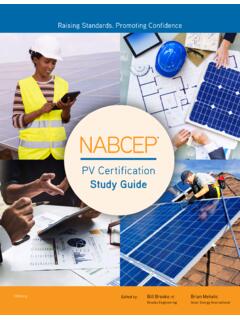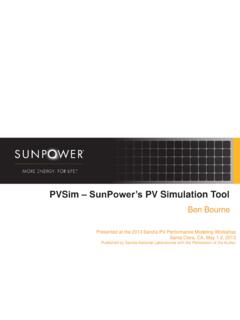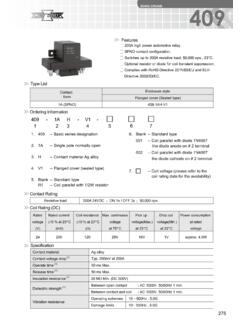Transcription of PV Technical Sales Job Task Analysis - NABCEP
1 2013 NABCEP 2013 NABCEP PV Technical Sales Job Task Analysis 1 Small Wind Resource Guide Rev 06/07/2010 NABCEP 2010N A B C E PPV Technical Sales Job Task Analysis Raising Standards. Promoting Confidence2 NABCEP PV Technical Sales Job Task Analysis 2013 NABCEP 2013 NABCEP PV Technical Sales Examination SpecificationsN Items Content Domain15 Qualify the Customer10 Site Analysis14 Conceptual Design5 Financial Costs, Incentives, and Savings4 Financial Benefit Analysis and Financing3 Non-financial Benefit Analysis5 Performance Analysis4 Prepare Proposals60 (total)Job Description.
2 A PV Tech Salesperson is a solar electric professional with demonstrated expertise in the siting, design, Analysis and performance of PV systems who gathers site specific information, analyzes customer needs and energy usage for the purpose of advising and provid-ing customers with the most appropriate solution for their situation. A. Qualify the Customer1. Analyze electric bill Gather bills Look for seasonal patterns Look at different fuel sources being used Review utility rates Explain why solar may not be appropriate2. Perform remote site assessment Determine house orientation Determine roof tilt/angle, available area Determine shading Evaluate obstructions Inquire about type and condition of roof Determine ownership status Determine type of property (residential commercial, non-profit)Knowledge of: -How site conditions impact feasibility of solar system -Internet tools -The limitations of remote tools -Magnetic declinationNABCEP PV Technical Sales Content 2013 NABCEP 2013 NABCEP PV Technical Sales Job Task Analysis 3 Small Wind Resource Guide Rev 06/07/2010 NABCEP 2010 3.
3 Identify customer needs Ask about reasons for going solar Evaluate future energy usage Determine desired time frame Determine whether customer needs financial assistance Determine electric usage pattern, time of day Discuss pros/cons of battery backup vs. generatorKnowledge of: -Basic Sales skills -Financial tools -The use electric rates function -Batteries -Electrical terminology -Correlating usage to specific appliances 4. Perform ball park estimate Estimate array size based on kWh consumption and available array area Price array size based on average $/watt Evaluate potential price adders Factor in incentives Develop price range Develop savings estimate Develop preliminary economic Analysis Present (verbally/brief) initial ballpark proposal and benefits Discuss customer budget limitsKnowledge of: -Price adders -Roof type -Licensing requirements -How the height of building impacts installation costs -Impact of long runs of conduit, wiring on costs -Steepness -Distance from load center5.
4 Identify jurisdictional issues Determine zoning Determine fire marshal awareness Determine reservation issues Check city, county and utility requirements Identify utility Identify homeowner associationKnowledge of: -Zoning issues for your area -Codes for your area -Utilities process, interconnection procedures, rules -Laws relating to homeowner s associations -Insurance limitations6. Manage customer expectations Advise customer that system doesn t provide backup power; when grid is down, it won t work Explain differences between battery and non-battery systems Explain that PV does not heat water, space, or pools Explain that PV generates electricity, does not offset gas loads Explain seasonal variations in output Explain required level of routine maintenance Explain system equipment manufacturer warranties Review life expectancy of equipment Discuss aesthetics Discuss ROI Explain emerging vs.
5 Existing technologies Explain expected output vs. system capacity Explain instantaneous power vs. annual energy production Explain installation warranties Explain manufacturer warranties Explain insurance issues, workers comp, liability Explain effects on homeowner s insurance Explain potential impact on roof warranty Explain performance validation methods4 NABCEP PV Technical Sales Job Task Analysis 2013 NABCEP 2013 Knowledge of: -Basic solar system knowledge -General financial understanding -Product knowledge -Knowledge of return on investment -Product limitations B. Site Analysis1.
6 Inspect electrical service Determine service rating current and voltage Identify buss bar and main breaker Identify line tap vs. panel upgrade Determine available breaker space Determine grounding Identify manufacturer of panel Determine method of interconnection Determine limits (max back fed breaker) based on local electrical code Inform customer of potential additional costs related to utility hardware, transformers Discuss findings with customerKnowledge of: -Electrical safety -OSHA -Electrical principles -Electrical codes 2. Identify locations for system components Identify inverter location Identify array location options Identify AC & DC disconnects Identify junction box Locate conduit runs Identify utility disconnect if applicable Determine lengths of conduit runsKnowledge of: -NEC and manufacturer clearance requirements -Solar exposure -Hazards ( , power lines, gas lines, meters) -The difference between AC & DC disconnects -Voltage ratings on fuses, AC & DC switches -Utility differences on requirements for disconnects -Tape measure -Laser level3.
7 Assess mounting location Identify roofing material Identify framing Identify spacing and spans Determine if there is an attic space vs. flat roof Assess structural integrity of roof (look at underside) Document condition of roof (photos, notes, etc.) Determine soil composition for ground/pole mounts Identify underground obstructions (septic, gas lines) Determine solar exposure Measure roof area or ground areaKnowledge of: -Roofing materials -Basic framing -Standard building practices (spacing) -Roofing terminology -Risks of falling -Walking on roofs without causing damage -Reading blueprints -Angle gauge -Safety 2013 NABCEP 2013 NABCEP PV Technical Sales Job Task Analysis 5 Small Wind Resource Guide Rev 06/07/2010 NABCEP 2010 4.
8 Perform shade Analysis Identify existing shading obstructions Consider future shading obstructions Perform inter-row shading Analysis Complete shade study Analyze annual loss from shading Analyze seasonal/daily variations in shade Determine whether rooftop Analysis is necessary If safe, proceed with rooftop Analysis If necessary, bring in crew for rooftop Analysis If rooftop Analysis is not feasible, incorporate buffer Calculate within acceptable limits of third-party audit, 3-5% Prepare the reportKnowledge of: -The impact of shade on solar systems -The proper use of the available tools C.
9 Conceptual Design1. Select appropriate equipment Explain module aesthetic options to customer Explain efficiency, cost, aesthetic differences Consider geographic location, climate Select the module(s) Match inverter to array Match inverter to service voltageKnowledge of: -Product -Voltage windows -Websites that provide insolation data2. Determine equipment location Avoid locations that will expose modules to salt water Comply with manufacturer specifications for inverter location Discuss potential sites for inverter with customer Ask customer about long term plans for renovations, etc.
10 Consider type of monitoring system, broadband vs. wired Discuss conduit runsKnowledge of: -Noise level generated by equipment -Risks of damage to equipment -NEC requirements and local codes (AHJ) -Cooling requirements -Manufacturer s clearances -Fire department requirements6 NABCEP PV Technical Sales Job Task Analysis 2013 NABCEP 2013 3. Plan system layout Determine module layout Determine electrical layout Determine which faces of roof to use Sketch system layoutKnowledge of: -String layout -Roof set backs -Geometry -Computer skills -Spacing between modules 4. Perform string sizing Select string sizing method Consider min, max temperatures, site Stand off distance (re: airflow) Match array voltage to inverter voltage with applicable temperature conditions Consider module voltage degradation over timeKnowledge of: -Applying temperature coefficients -Correlation between temperature and voltage 5.












